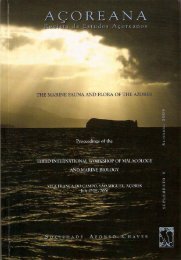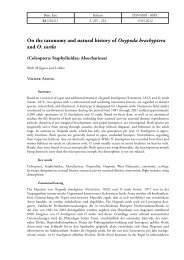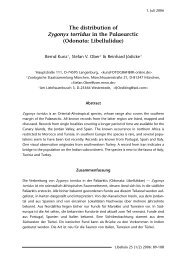(eds.) (2005). - Portal da Biodiversidade dos Açores - Universidade ...
(eds.) (2005). - Portal da Biodiversidade dos Açores - Universidade ...
(eds.) (2005). - Portal da Biodiversidade dos Açores - Universidade ...
You also want an ePaper? Increase the reach of your titles
YUMPU automatically turns print PDFs into web optimized ePapers that Google loves.
problemas de <strong>da</strong><strong>dos</strong> estiveram apenas associa<strong>dos</strong> à<br />
falta de informação específica acerca de várias características<br />
do nicho <strong>da</strong>s espécies.<br />
Um trabalho recente e não publicado, Chefaoui<br />
(<strong>2005</strong>) mostra que os resulta<strong>dos</strong> <strong>da</strong> modelação preditiva<br />
de uma espécie herbívora são francamente<br />
melhora<strong>dos</strong> quando se inclui no modelo, informação<br />
específica acerca <strong>da</strong> distribuição <strong>da</strong>s espécies vegetais<br />
de que a espécie se alimenta. Os mapas de distribuição<br />
potencial de uma emblemática borboleta<br />
ibérica, Graellsia isabelae, desenvolvi<strong>dos</strong> a partir<br />
de <strong>da</strong><strong>dos</strong> ambientais comuns (características do solo<br />
e do clima), melhoraram muito quando os <strong>da</strong><strong>dos</strong> de<br />
distribuição <strong>da</strong> espécie de Pinus em que esta borboleta<br />
se alimenta (<strong>da</strong><strong>dos</strong> <strong>da</strong> versão actualiza<strong>da</strong> do<br />
Mapa de Florestas Digital Espanhol; Ruiz de la<br />
Torre 2002) foram incluí<strong>dos</strong> como preditores.<br />
Esta informação adicional, adequa<strong>da</strong> ao conhecimento<br />
<strong>dos</strong> requisitos de ca<strong>da</strong> espécie, deve permi-<br />
tir produzir melhores mapas <strong>dos</strong> quatro escaravelhos<br />
endémicos agora estu<strong>da</strong><strong>dos</strong>. Por exemplo, T.<br />
terrabravensis é provavelmente uma espécie humícola,<br />
encontra<strong>da</strong> em sistemas complexos de fracturas<br />
e buracos profun<strong>dos</strong> <strong>dos</strong> terrenos basálticos <strong>da</strong>s florestas<br />
<strong>da</strong> Terra Brava e Caldeira <strong>da</strong> Serra de Santa<br />
Bárbara, que estão cobertos por um denso material<br />
de musgos e fetos produzindo um solo muito ensombrado<br />
(Borges et al. 2004). Por outro lado, a<br />
espécie parece preferir folha<strong>da</strong> domina<strong>da</strong> pelas espécies<br />
de louro (Laurus azorica) e azevinho (Ilex<br />
perado ssp. azorica) <strong>da</strong> Macaronésia. Assim, a inclusão<br />
<strong>da</strong> informação acerca <strong>da</strong> distribuição de solos<br />
com fracturas de grandes dimensões, bem como a<br />
distribuição <strong>da</strong>s florestas nativas domina<strong>da</strong>s por árvores<br />
com folhas grandes, melhorariam certamente<br />
a precisão do mapa preditivo. Do mesmo modo, por<br />
exemplo, o conhecimento de <strong>da</strong><strong>dos</strong> acerca <strong>da</strong> distribuição<br />
do tipo de floresta onde C. azoricus azoricus<br />
habita, ou acerca <strong>da</strong> compactação do solo que pode<br />
afectar a distribuição de T. terceiranus, pode melhorar<br />
a precisão <strong>dos</strong> seus modelos. A disponibili<strong>da</strong>de<br />
de informação exacta sobre a composição e características<br />
<strong>da</strong> vegetação e tipos de solo parecem fun<strong>da</strong>mentais<br />
para a utilização <strong>dos</strong> <strong>da</strong><strong>dos</strong> ATLANTIS. A<br />
obtenção e/ou disseminação dessa informação deve<br />
consequentemente ser encoraja<strong>da</strong>.<br />
102<br />
In a recent unpublished work, Chefaoui (<strong>2005</strong>)<br />
shows that the results of the predictive modelling<br />
of a plant-eating species are largely improved<br />
when specific information on the observed distribution<br />
of vegetation species where the species<br />
fe<strong>eds</strong> is included in the set of predictors.<br />
The potential distribution maps of an emblematic<br />
Iberian butterfly species, Graellsia isabelae,<br />
developed from common environmental <strong>da</strong>ta<br />
(climate and soil characteristics), were highly<br />
improved when information about the distribution<br />
of the Pinus species where this species fe<strong>eds</strong><br />
(coming from the up<strong>da</strong>ted version of the Spanish<br />
Digital Forests Map; Ruiz de la Torre 2002), were<br />
used as predictors.<br />
Such additional information, suited to the<br />
knowledge about the requirements of each species,<br />
should allow us to produce better maps of the<br />
four endemic beetles here studied. For example,<br />
T. terrabravensis is probably a litter species,<br />
found in the complex system of cracks and deep<br />
holes of the basaltic terrain of the forests in Terra<br />
Brava and the Caldeira de Santa Bárbara, which<br />
are covered by a dense carpet of mosses and<br />
ferns that produce a shady ground floor (Borges<br />
et al. 2004).<br />
Moreover, the species seems to prefer leaf<br />
litter dominated by the Macaronesian Laurel<br />
(Laurus azorica) and the Azorean Holly Tree (Ilex<br />
perado ssp azorica).<br />
Thus, including information about the distribution<br />
of soils with large crevices, as well as<br />
the distribution of large-leaf dominated native<br />
forests used for his model, will improve the<br />
accuracy of the predictive map. In the same way,<br />
<strong>da</strong>ta on e.g. the distribution of the type of forest<br />
where C. azoricus azoricus inhabits, or on the<br />
soil compactness that may affect T. terceiranus<br />
distribution, will improve the reliability of their<br />
respective models.<br />
The availability of accurate information about<br />
the composition and characteristics of vegetation<br />
and soil types appears to be a keystone for the<br />
use of ATLANTIS <strong>da</strong>ta.<br />
The gathering and/or dissemination of such<br />
information should consequently be encouraged.

















